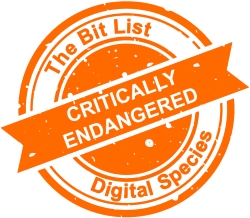Digital Archives of Music Production
 |
||
|
Digital materials created by musicians and fans as a by-product of performance or recording, not otherwise published or shared. The use of ‘archives’ in this context refers to music production data that is in an archive. |
||
|
Digital Species: Sound and Vision |
Trend in 2023:
|
Consensus Decision |
|
Added to List: 2019 |
Trend in 2024:
|
Previously: Critically Endangered |
|
Imminence of Action Action is recommended within twelve months, detailed assessment is a priority. |
Significance of Loss The loss of tools, data or services within this group would impact on people and sectors around the world. |
Effort to Preserve | Inevitability It would require a major effort to prevent losses in this group, such as the development of new preservation tools or techniques. |
|
Examples Pre-production notes; demo recordings; photography; correspondence. |
||
|
‘Practically Extinct’ in the Presence of Aggravating Conditions Fragile or obsolete media for offline content; service provider preservation capability for online content; dependence on proprietary formats or products; lack or loss of documentation; Uncertainty over IPR or the presence of orphaned works; lack of version control; lack of policy or mandate. |
||
|
‘Endangered’ in the Presence of Good Practice Replication; clarity of intellectual property rights; preservation agency involved and capable of looking after content. |
||
|
2023 Review In 2019, this entry was created as a subset of a previous 2017 entry, ‘Digital Music Production and Sharing,’ which was split to draw attention to the different challenges faced by the different forms. Although it overlaps with other entries, including ‘Pre-production TV and Movie materials,’ it is a separate entry to emphasize the value of the archival materials relating to the recording process over and above the recordings themselves. The 2020 and 2021 Juries, as well as the 2022 Taskforce, agreed with the entry’s assigned risk classification, with risks remaining on the same basis as before (no change to the trend). The 2023 Council also agreed with the Critically Endangered classification, with overall risks remaining on the same basis as before (‘No change’ to trend), though they noted that action needed to be taken more imminently. |
||
|
2024 Interim Review These risks remain on the same basis as before, with no significant trend towards even greater or reduced risk (‘No change’ to trend). |
||
|
Additional Comments For the imminence of action, it will all depend on the format of the records. Correspondence or photographs may be left for longer, but recordings will need closer attention, especially if it is a bespoke recording format. This may be less of a digital preservation challenge and more of an archive or collecting challenge. This type of material in the past, like most 'unpublished' archives, has survived through luck and is largely out of a GLAM or institution’s control relying on individuals to assess and evaluate if what they have is of significance. When these types of things come to an institution, based on significance on a case-by-case basis, are these digital objects then considered 'worth' the effort to a) bring into the collection and b) care and preserve them? So yes, while Critically Endangered, these types of collections are enormous and quite often not things one would want to keep for the long term; however, sometimes there is the odd gem. There is the recognized inevitable loss of existing data but reducing this loss would require major effort to fix in terms of identifying organizations who are preserving this content, and it is not clear that this is being done already. See also:
|
||





































































































































